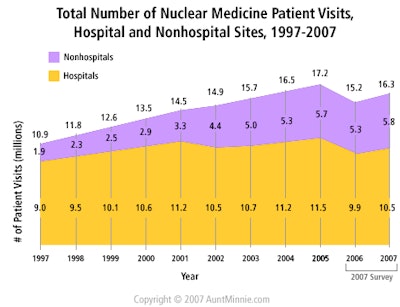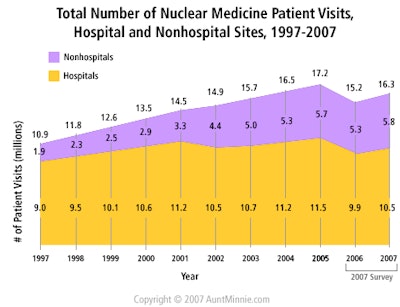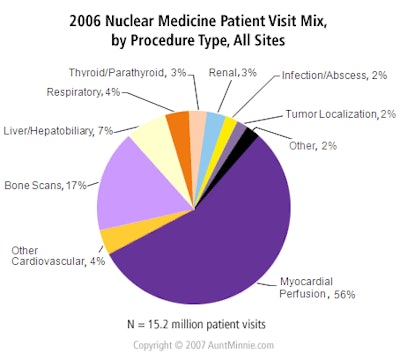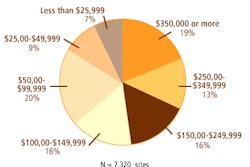
The total number of patient visits for nuclear medicine procedures declined in 2006, but shows a rebound in 2007, based on results for the first half of this year.
The study by IMV Medical Information Division of Des Plaines, IL, estimates there were 15.2 million patient visits in the U.S. in 2006, compared with 17.2 million in 2005, a decline of 12% among 7,320 hospital and nonhospital sites.
The drop in patient visits appears to be temporary, as IMV projects the number will rise this year, based on survey results through July, to 16.3 million in 2007. If that forecast is accurate, the total still is below the 2005 level.
IMV's senior director of market research Lorna Young speculated that the decrease from 2005 to 2006 and 2007 may be due, in part, to precertification requirements from health insurance companies, which require patients to obtain insurer approval for imaging services prior to scheduling their procedure. "Insurance companies are increasingly requiring patients to obtain precertification approval for certain imaging procedures, such as nuclear medicine," she said.
 |
Young added that other modalities, such as PET/CT may be "stealing" oncology procedures that previously belonged solely to nuclear medicine. Cardiology procedures continue to be a key application of nuclear medicine SPECT cameras, as myocardial perfusion procedures are continuing to grow as a proportion of total nuclear medicine patient visits. As for oncology, PET/CT may be cannibalizing some nuclear medicine procedures, even though PET/CT procedures also may be subject to precertification rules.
Procedure types
Of the 15.2 million nuclear medicine patient visits in 2006, 60% were for cardiovascular procedures, which were primarily myocardial perfusion studies. Nearly one in five visits was for bone scans, followed by liver/hepatobiliary at 7%, and respiratory at 4%.
Overall, the portion of cardiovascular imaging studies has increased from 54% of total studies performed in 2002 to 60% of those performed in 2006.
 |
Pharmaceutical budgets
Healthcare facilities continue to allocate a healthy portion of their budgets for radiopharmaceuticals. For 2007, more than one-third of the nuclear medicine sites budgeted as much as $100,000 for radiopharmaceuticals; approximately 16% of the respondents' budgets were between $100,000 and $149,000; almost 30% were in the range of $150,000 to $349,000. Nearly one in five nuclear medicine sites had budgets that were greater than $350,000.
"The distribution reflects a continuation of the growth of radiopharmaceutical budgets since 1999," Young noted. "Between 1999 and 2007, the proportion of sites with budgets of $250,000 or more has increased from 15% to 32% of the sites."
The IMV report also estimates that $1.61 billion was spent for radiopharmaceuticals in 2005.
Installed base
Through July 2007, IMV's study estimated the nuclear medicine camera installed base in the U.S. to be 13,130 stationary installations at 7,180 sites. The total includes some 9,000 cameras at 3,970 hospitals, and 4,130 cameras at 3,210 nonhospital sites, which are primarily cardiology practices.
While procedures have experienced some downturn from 2005 to the middle of 2007, the nuclear medicine camera installed base increased slightly -- approximately 2% -- in both hospital and nonhospital sites. About half of the installed base includes cameras that are less than five years old. Between 2000 and 2006, more than 1,100 cameras have been installed on average each year, with replacement cameras being the primary motivation for more than 75% of the purchases.
Emerging SPECT/CT
"SPECT/CT is starting to emerge as a viable option in the nuclear medicine market," Young said. "While only 1% of the total installed base were SPECT/CT cameras, more than 10% of the cameras installed in 2007 to date have been SPECT/CT."
Meanwhile, over the last six years, dual-head SPECT installations have grown from more than 40% of the total installed base to two-thirds today. Conversely, single-head SPECT cameras declined sharply from approximately half to one-quarter of the installed base over the same period.
By Wayne Forrest
AuntMinnie.com staff writer
October 16, 2007
Disclosure notice: AuntMinnie.com is owned by IMV, Ltd.
Related Reading
SPECT/CT offers better bone scan views to enhance treatment, September 21, 2007
Development progresses on CZT-based MR/SPECT prototype, September 14, 2007
FDG-PET could help unlock secrets of atherosclerotic plaque, August 2, 2007
Interest surges in use of imaging for tracking radiation therapy, July 31, 2007
Israeli group test-drives 64-slice SPECT/CT system for cardiac imaging, June 6, 2007
Copyright © 2007 AuntMinnie.com




















